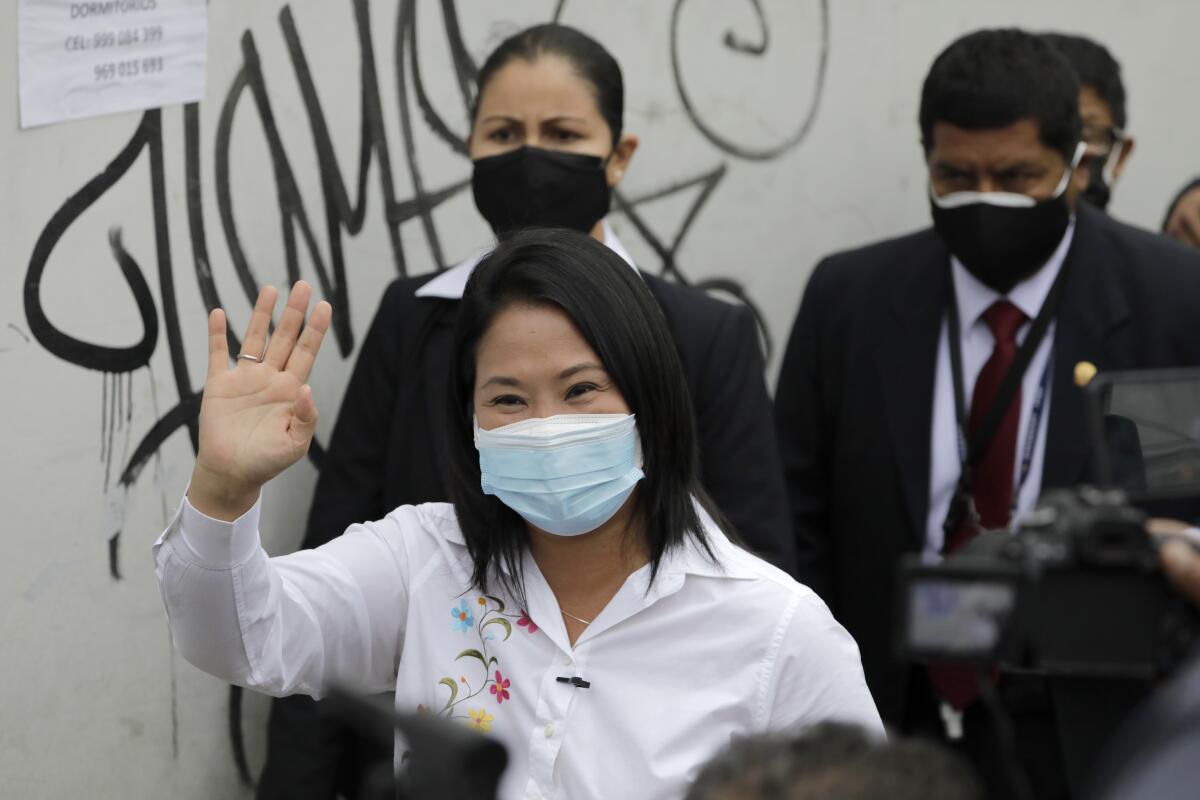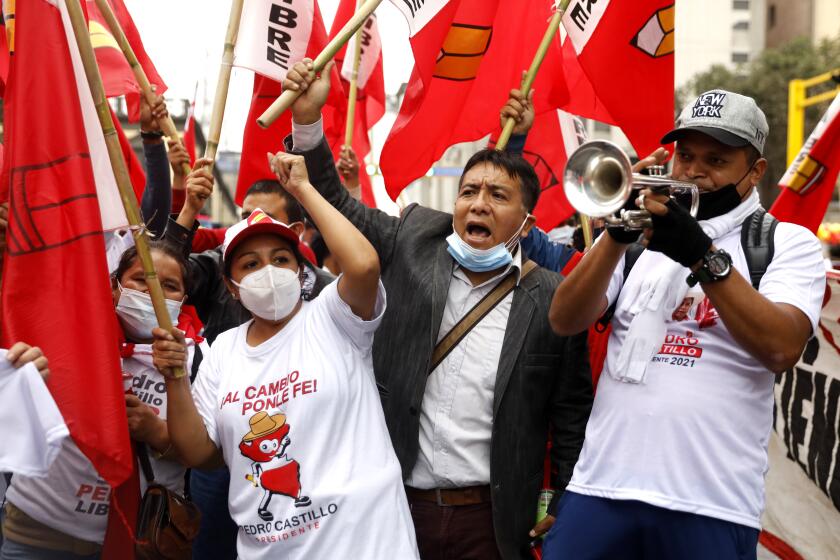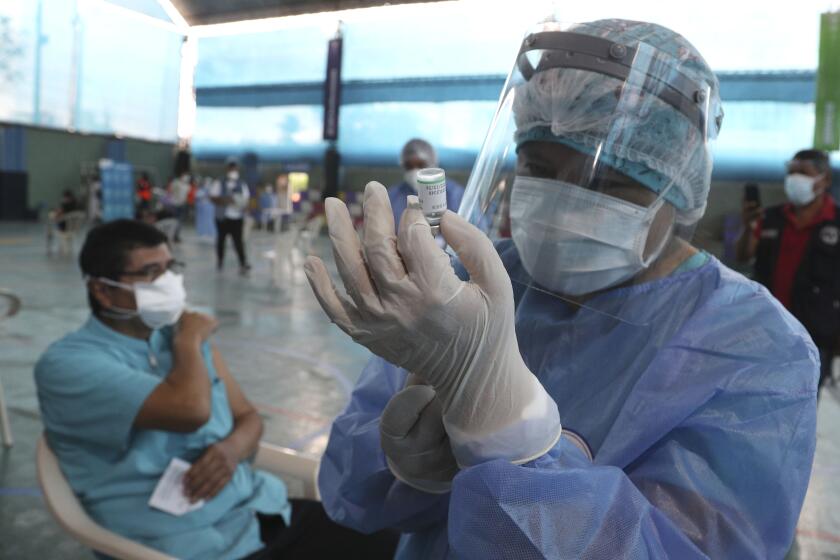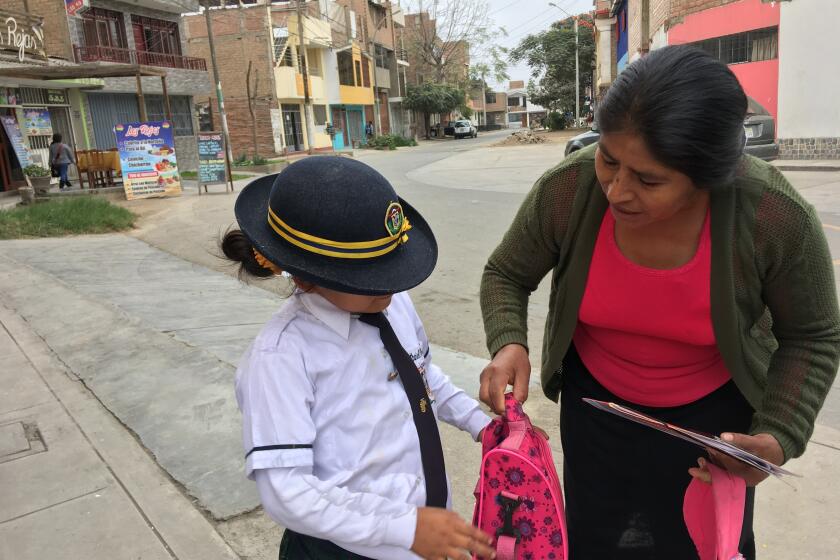Peru’s presidential runoff election too close to call

- Share via
LIMA, Peru — A teacher-turned-politician and the daughter of an imprisoned former president traded the lead Monday in a close race for Peru’s presidency.
With 95% of the ballots tallied in the runoff election, leftist Pedro Castillo had 50.2% of the vote, while conservative Keiko Fujimori had 49.7%, according to official results. This is Fujimori’s third run for president, a role her father held in the 1990s.
The difference between the two polarizing candidates was just over 87,000 votes. The figures, released by Peru’s National Office of Electoral Processes, included almost all votes cast near the country’s electoral processing centers. The agency was still awaiting the arrival of votes from remote rural areas and abroad.
“No one can say for sure at this point who is going to win,” Fernando Tuesta, a political scientist at the Pontifical Catholic University of Peru and former Peruvian elections chief, told a local radio station. In 2016, Pedro Pablo Kuczynski defeated Fujimori in a presidential election by just 42,597 votes.
The partial map of votes showed a country split in two. Castillo overwhelmingly dominated the impoverished rural areas of the Andes and much of the Amazon. Fujimori was the candidate of the business elite, dominating in the capital and other cities on the Pacific coast.
The cities hardest hit by the Shining Path rebel group during Peru’s internal conflict between 1980 and 2000, which left almost 70,000 people dead, voted for Castillo. It was an adverse result for Fujimori, who during the campaign accused the teacher, without evidence, of ties to terrorism.
The areas where international mining companies are seeking to expand extractive projects also voted almost entirely for Castillo. In the country’s poorest district, Uchuraccay, he captured 87% of the votes, while in the richest district, San Isidro, Fujimori prevailed, with 88%.
Neither candidate made statements Monday. Castillo left the Andean district of Tacabamba early to travel to Lima.
The polarizing populist candidates have promised COVID-19 vaccines for all and other strategies to alleviate the health emergency that has killed more than 180,000 people in Peru and pushed millions into poverty. The election followed a statistical revision from Peru’s government that more than doubled the COVID-19 death toll previously acknowledged by officials.
Sunday’s presidential election in Peru comes as many citizens are losing hope for their economy and their democracy.
Voters across Peru, where voting is mandatory, headed to the polls Sunday under a set schedule meant to minimize long lines.
Pre-election polls indicated that the candidates were virtually tied heading into the runoff. In the first round of voting, featuring 18 candidates, neither received more than 20% support, and both were strongly opposed by sectors of Peruvian society.
Seizing on COVID-19 to expand its global influence, China has emerged as a major player in the vaccine sweepstakes — particularly in Latin America.
“The candidate who becomes [president], either Keiko or Pedro, the people, the only thing we have to do is accept it, but they better govern well,” said Lucia Carrion, a street vendor in Lima. “There is so much corruption. One of them has to stop so much corruption that there is here in Peru.”
The coronavirus has not only overwhelmed Peru’s medical and cemetery infrastructure, left millions unemployed and highlighted longstanding inequalities; it has also deepened people’s mistrust of the government, which many believe mismanaged the pandemic response. A secret vaccination drive for the well-connected erupted into a national scandal.
Amid protests and corruption allegations, Peru cycled through three presidents in November. Analysts warn that this election could be another tipping point for the population’s simmering frustrations and bring more political instability.
Ex-President of Peru Alberto Fujimori and three of his health ministers are facing prosecution for a program in which women were allegedly sterilized without consent.
President Francisco Sagasti said the candidates should respect the election results and ask their followers to refrain from staging protests over the outcome. Fujimori asked her followers to be prudent because “the margin is so small,” while Castillo demanded a review of all ballots to “guarantee the true popular will of the Peruvian people.”
Fujimori, a former congresswoman, has promised various bonuses to citizens, including a $2,500 one-time payment to each family with at least one COVID-19 victim. She has also proposed distributing 40% of a tax for the extraction of minerals, oil or gas among families who live near those areas.
Fujimori’s father, Alberto, governed between 1990 and 2000 and is serving a 25-year sentence for corruption and the killing of 25 people. Keiko Fujimori — who has also spent time in prison, as part of a graft investigation — has promised to free him if she wins the election.
Breaking News
Get breaking news, investigations, analysis and more signature journalism from the Los Angeles Times in your inbox.
You may occasionally receive promotional content from the Los Angeles Times.
Castillo until recently was a schoolteacher in the country’s third-poorest district, deep in the Andes. The son of illiterate peasants entered politics by leading a teachers’ strike. While his stance on nationalizing key sectors of the economy has softened, he remains committed to rewriting the constitution that was approved under the regime of Fujimori’s father.
Peru is the world’s second-largest copper exporter; mining accounts for almost 10% of its GDP and 60% of its exports, so Castillo’s initial proposal to nationalize the mining industry set off alarm bells among business leaders. But regardless of who gets picked to succeed Sagasti on July 28, investors are expected to remain skittish.
Both candidates oppose abortion and same-sex marriage.
The stock market in Lima registered declines of more than 7% and, complying with regulations, closed its operations for 20 minutes and then reopened. The dollar exchange rate also reached a record high.
More to Read
Sign up for Essential California
The most important California stories and recommendations in your inbox every morning.
You may occasionally receive promotional content from the Los Angeles Times.













